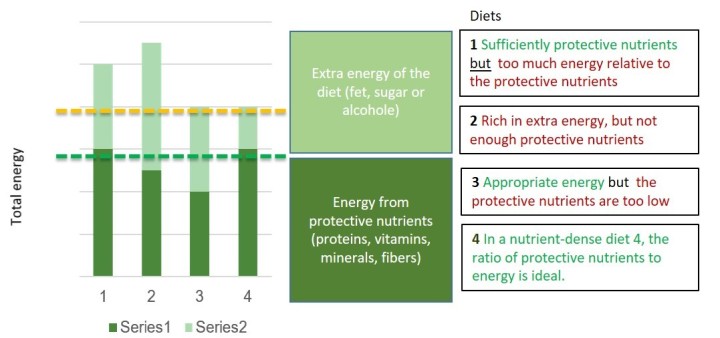Nutrition
Food plays a key role in advancing human health and well-being, as nutrition affects daily work capacity and the development of diseases that cause premature disability for work. The basis for the nutrition assessment is the recommended dish model and food pyramid. The key is the balance of nutrition, exercise, recovery and sleep:
Nutri-Flow focuses on individual nutrition guidance that supports recovery and the achievement of exercise goals, as well as improving sleep quality.
- Nutri-Flow provides the basis for a balanced, individual and recommended diet.
- For physical activity, services developed for individual monitoring can be used.
- Individual measurement and analysis of the amount and quality of sleep are available.
Nutri-Flow focuses on individual nutrition guidance that supports recovery and the achievement of exercise goals, as well as improving sleep quality.
What is nutritional value i.e. nutrient density
Nutrient density tells you how much nutrients your body needs in relation to the amount of energy it contains. Protective nutrients include e.g. vitamins, fibers and minerals.
Often, fresh, little-processed, or processed foods, such as vegetables, have a high nutrient density. When the nutrient density is low, the food has a lot of so-called empty energy, i.e. a lot of energy but little protective nutrients.
Even if the daily energy requirement decreases, the need for nutrients will not decrease. Thus, there is a risk of reducing the amount of nutrients needed when reducing the amount of energy in food.
 |
Importance of nutrient density in diets (Nutritional expert of Nutri-Flow Oy):
- Diet 1 is the most common, providing enough protective nutrients but too much energy relative to the protective nutrients.
- Diet 2 is rich in extra energy, but not enough protective nutrients.
- Diet 3 describes the most common diet for a dieter, the elderly or children, where the amount of food is small and the protective nutrients are low because no attention has been paid to the content of the food.
- In a nutrient-dense diet 4, the ratio of protective nutrients to energy is ideal.
Nutrition information in the calculations
- Since 1956, nutrition has been evaluated on the basis of energy. By focusing only on estimating the appropriate amount of energy, the kilocalorie count does not use other existing data on the composition of the diet.
- Since 1999, the calculation of nutrient density has been used in nutrition assessment and by researchers.
- Nutrient density tells how much nutrients body needs in relation to the amount of energy it contains.
- The calculation of nutrient density has been developed in France, Germany and Finland.
- Only in Finland is an intelligent nutrient density calculation service used: .Learn more about how Nutri-Flow workspalvelut.php?
Nutrients for energy
Intestinal bacteria
Comprehensive scientific basis
Health
 |
Questions that promote nutritional choices
- How do you feel about your daily meals (well-being)?
- How have you noticed that a meal affects your physical or mental state?
- On what basis do you make your food choices?
- What do you think is important for breakfast, lunch and dinner as well as snacks?
- Have you tried different diets, what kind?
- Have you developed a meal rhythm?
- Have you noticed that your meal rhythm affects your ability to function or your development?
- How important is the quality of food to you?
- How do you plan your daily meals?
- Do you use recipes?
- Do you make a shopping list?
- Have you researched the contents of your food?
- On what basis do you choose what you eat when you eat out?
Tips for food conversation
- Positive attitude to eating
- a true understanding of one's own body
- Food choices are made according to individual needs
- Meals are perceived as enjoyable
- The diet is developed by making observations
- Regular meal rhythm
- Dining takes into account the needs of functional capacity and development
- The nutritional value and proper timing of meals have been taken into account
- Planned meals daily
- Planned grocery shopping
- Healthy choices when eating out